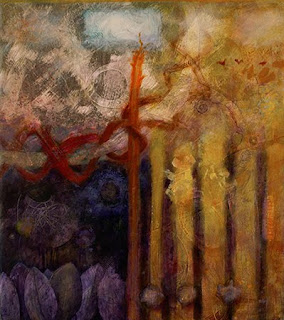
Friend, artist and photographer, Mary S, Rezny, is having an invitational exhibit in her studio in a couple of weeks. The title of the show is "Red." My take on the theme is this recently finished piece which I've called, "Sailor's Delight." The reference is two-fold: first the weather aphorism "Red sky at morning, sailor take warning. red sky at night, sailor's delight," second, the row of light dots in the lower right resemble harbor lights. I sometimes struggle with titles for abstract paintings. There are always the risks of being too literal, or too esoteric, or too... cute. I usually wind up making some reference that I feel gives people a starting point to engage the painting. I'm not really so concerned where they end up though. If someone finds their imagination and emotions activated by the piece, that alone is a good thing. Especially if they are unaccustomed to looking at the world this way. My goals are to challenge and reward viewers in a ways that are both intellectually stimulating and emotionally satisfying. No, it's not cutting edge, but I'm still finding lot's of room to explore here. Hopefully others will too.
This is a small piece, only 9" x 10." The medium is acrylic and Tyvek on a wood panel.















